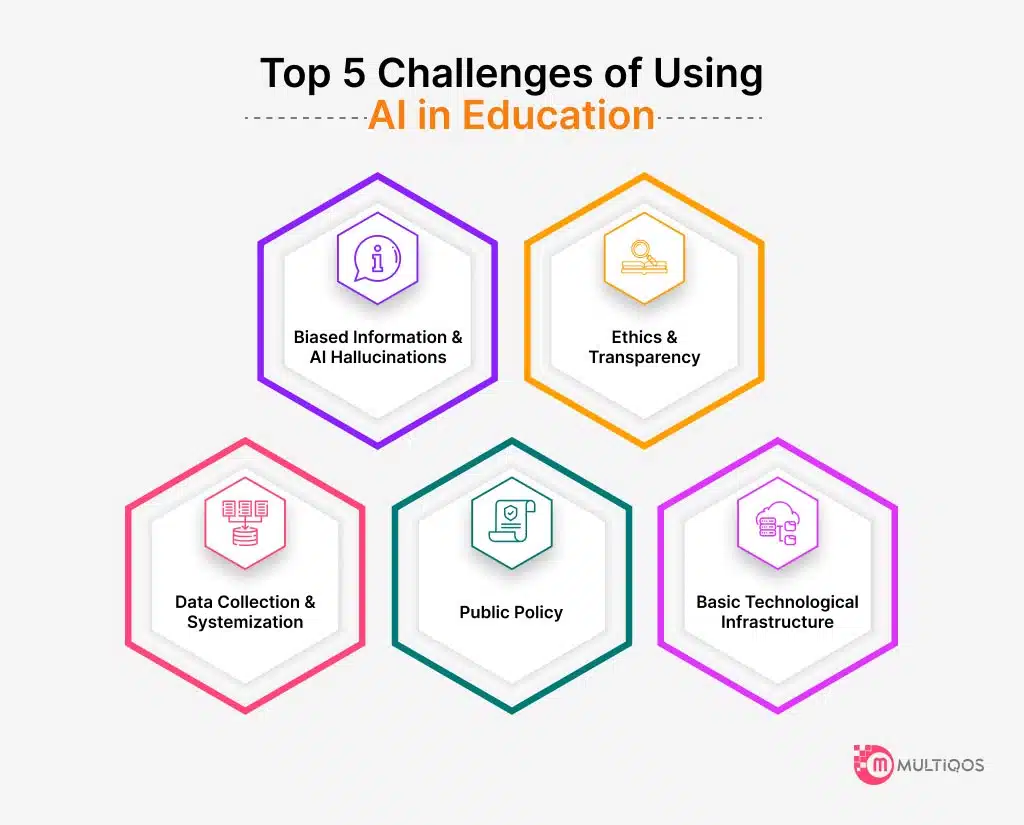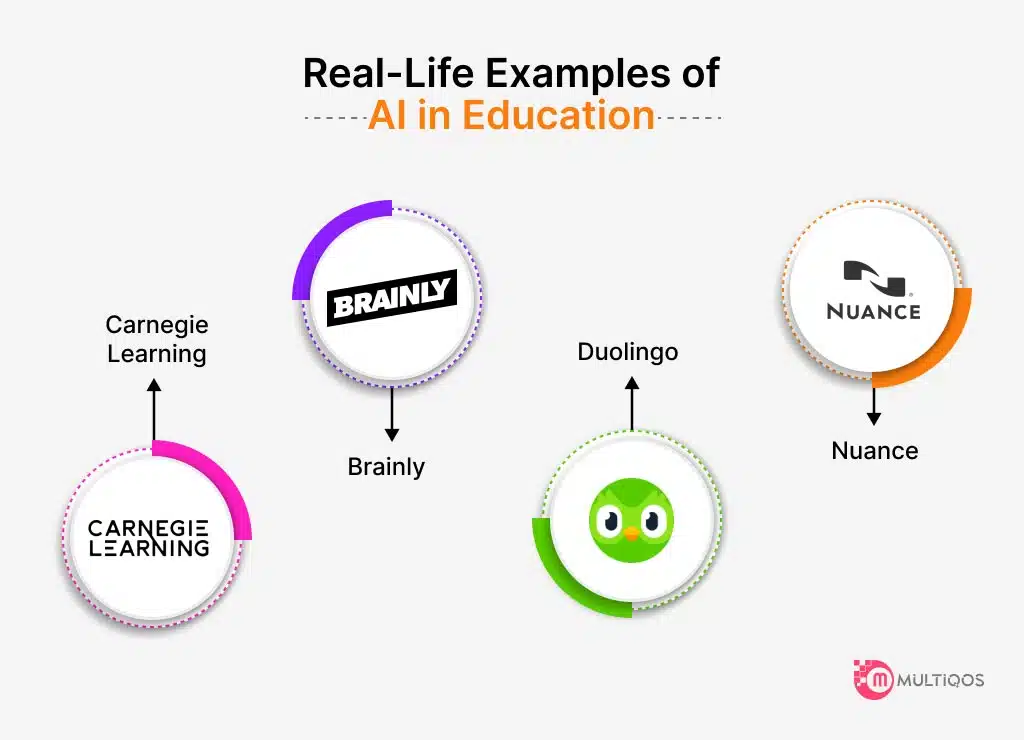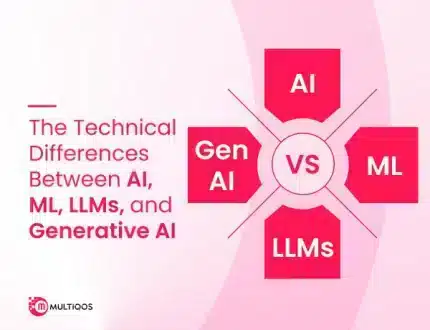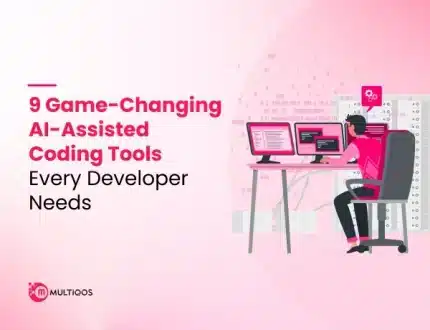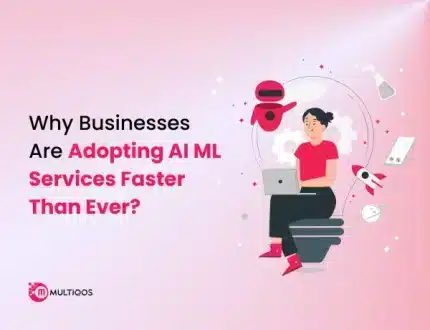The Role of AI in Education Industry: Use Cases, Challenges, and Future
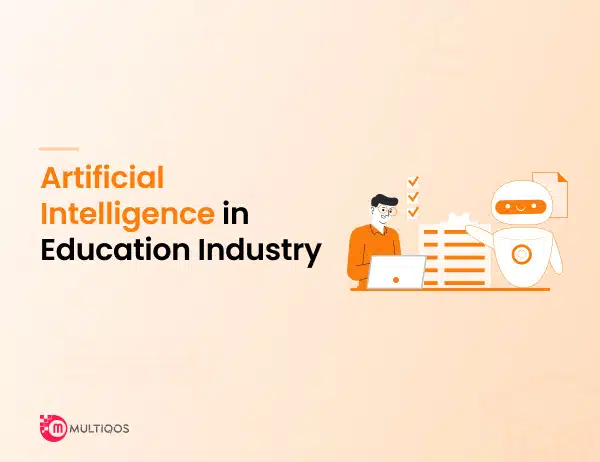
Introduction
Education, like many other facets of our life, is becoming increasingly reliant on technology. Artificial intelligence (AI) is emerging as an effective tool for curriculum transformation. AI-powered education services use natural language processing, machine learning, and neural networks to provide breakthroughs such as virtual teachers, AI learning aides, and tailored learning routes.
The EdTech companies have taken AI in education to the next level by top-notch by offering features and functionalities powered by this widely adopted technology. For entrepreneurs knowing about these applications of AI in education would enable them to step into opportunities which they can grab to build successful EdTech.
But before that knowing about the number would provide you with an idea of why this technology is and would continue to be a substantial part of the education industry.
Glimpse into the AI-Driven Future of the Education Industry
AI’s Impact on the Evolution of Learning
With the presence of AI-powered tools and software around in every technological aspect whether it is generation AI or any such tool. The adoption of AI seems more like a paradigm shift than just an evolution. Here are some stats showcasing the growing use of AI in the education industry:
The AI in education market is expected to skyrocket, from $3.79 U.S. dollars in 2022 to a whopping $20.54 U.S. dollars in 2027. This represents an impressive compound annual growth rate (CAGR) of 45.6% over the forecast period from 2022 to 2027.
Until today, the worldwide market for AI in education witnessed significant growth, expanding from USD 537.3 million in 2018 to USD 3,683.5 million by 2023. This remarkable increase reflected a CAGR of 47.0% over the forecast period.
According to a market forecast by Statista, in 2019, the worldwide e-learning market was valued at nearly $200 billion. Fast forward to 2026, and the forecast indicates that the global e-learning market is expected to reach close to $400 billion.
These stats are an attestation to the growing use of AI in education and a glimpse into what the future of AI in education will look like.
Now that we have an idea of the future of AI in education, it is time to understand the application of AI in education which will make it possible.
How AI Revolutionizes Students’ Learning Experiences?
From personalized learning experiences to helping teachers better understand their students, AI can have numerous applications catering to various requirements of teachers and students alike. Here are some such applications of artificial intelligence in the education industry:
-
AI Tutor
Imagine students having a tutor in their personal space capable of assisting them in studying the subjects they are weak in, prepping for their weekly exams or even with the finals. And all of this in an interactive and fun way.
One of the best examples of it is Duolingo’s mascot – Duo the Owl! From providing gentle reminders to gamifying the learnings and challenging the learners, it is a virtual study buddy each student needs.
Apart from enabling each student to learn at their own pace, these tutors enable the teachers to provide the necessary support even in a full-strength class providing an inclusive learning experience to each student.
-
Data and Learning Analytics
A student can only fine-tune their strategy when they know where they are lacking and what improvements are needed. In the conventional education system, this was done based on tests that students give to give them an idea of the subjects they are weak in, so they can improve. But this analysis only provides them a generic idea.
AI, on the other hand, can not only analyse each and every test in detail to recognize every scope of improvement. Along with early identification of learning difficulties, AI-powered EdTech can also provide students with personalised learning plans which brings us to our next application of AI in education.
-
Personalized Learning
Every student has unique strengths, weaknesses, learning pace, styles and more. With the help of AI algorithms, educational platforms can analyze all these unique characteristics to provide each student with a tailored learning experience to meet their needs and preferences.
Personalized learning with AI empowers students to take control of their educational journey, enabling a more effective and enjoyable learning experience.
-
Inclusion and Universal Access
Another perspective of personalised learning can be realised with AI eLearning platforms that facilitate accessibility features such as speech-to-text and text-to-speech, benefiting students with varying learning preferences or those with disabilities. Hence caters to those who may have different preferences in how they absorb information.
By leveraging AI for inclusion and universal access, education can be made more equitable, ensuring every learner, regardless of their background or abilities has an opportunity to learn and thrive.
-
Automated and Improved Grading
We have all in some other ways faced problems due to the ineffectiveness of manual grading. From time consumption to human error, the manual grading system comes with its own set of limitations.
AI-empowered grading systems can not only take the burden off teachers but also provide quick and accurate evaluations. AI streamlines the grading process, making it more efficient, fair, and conducive to enhanced learning outcomes.
-
Generating Smart Content
Learning resources play a crucial role in helping the students not only guide through the lesson but also provide them with relevant information about learning a particular lesson or subject. But often the content available in the conventional learning materials is not engaging to the extent that the students lose interest in some subject.
AI on the other hand tailors educational materials to align precisely with specific learning objectives based on the granular data on student behaviour and learning patterns. This customization can encompass a range of interactive resources such as videos, quizzes, and simulations, ensuring that content is engaging, relevant, and optimally suited to each student’s individual needs and preferences.
-
Chatbots for Student Support
Imagine having a chatbot available 24/7 to help with homework or clarify confusing concepts. This is what an AI chatbot feels like.
These AI-powered helpers can answer questions, provide guidance on assignments, and even offer personalized learning recommendations. With these AI-powered chatbots, learners can get instant assistance, reducing frustration and improving overall academic performance.
These bots are programmed with vast amounts of educational content and can adapt their responses based on individual student needs. Whether it’s reviewing material, finding resources, or receiving encouragement, chatbots are invaluable partners in the educational process.
Top 5 Challenges of Using AI in Education
Although AI has immense potential for improving and aiding learning, deploying this technology in the classroom presents problems. However, it faces the same challenges as any other change. In this section, we’ll look at the top five barriers to implementing AI in education.
-
Biased Information and AI Hallucinations
Artificial intelligence systems are developed by analyzing massive amounts of data to identify trends and make forecasts or predictions. However, if there are biases in the initial training data, AI models could reinforce and exacerbate these preconceptions.
This means that the AI may make biased or problematic recommendations based on gender, color, age, or other characteristics.
For instance, AI recruiting tools show gender bias by favoring men in STEM roles based on historical hiring data. Credit and loan algorithms exhibit discrimination based on race and ethnicity when trained on biased financial data.
Overall, biased data and AI hallucinations present obstacles in developing ethical and trustworthy AI systems for education. Scrutinizing datasets and algorithms, implementing bias testing, and ensuring transparency around AI will be key to overcoming these hurdles.
-
Ethics and Transparency
One of the most significant obstacles in introducing AI into the classroom is the ethics and openness of the systems. Many AI systems operate as “black boxes,” making it unclear how they arrive at specific outputs or judgments. This lack of transparency poses serious ethical concerns, particularly when AI is used to make critical judgments such as student assessments, rankings, and so on.
Without clarity into how AI systems work, it is difficult to hold them accountable for errors or biases. There have already been reports of AI computers engaging in racist, sexist, or otherwise unethical conduct.
Overall, maintaining ethics and openness in instructional AI will necessitate constant collaboration among computer scientists, educators, and policymakers. Students deserve to learn if and how AI technology works.
-
Data Collection and Systemization
The success of AI systems relies heavily on access to large, high-quality datasets. However, collecting sufficient data can be a major obstacle to using AI in education. Educational data tends to be fragmented across different schools, districts, and systems. Student privacy laws also place restrictions on gathering data, especially for minors.
AI algorithms require the data to be organised and tagged in ways that enable computers to extract useful patterns. But much of the data collected by schools is unstructured, such as essays or audio/video recordings. While educational institutions tend to have limited IT resources compared to big tech companies developing AI products. Building the data pipelines and databases necessary to feed AI systems presents a considerable burden for schools.
-
Public Policy
Policymakers are still developing regulations around the use of AI in schools, carefully weighing the risks and benefits of these emerging technologies in the classroom. There is not yet a clear consensus on AI policies for education, and laws can differ significantly across states and countries.
Some areas policymakers are grappling with include:
- Privacy regulations around data collected on students. How much student data should AI systems be allowed access to and what safeguards need to be in place?
- Oversight of AI systems to ensure accuracy, fairness, and transparency. How can policymakers monitor for algorithmic bias or errors?
- Replacing human teachers and support staff with AI. What policies need to be in place as AI takes on more responsibilities in schools traditionally performed by people?
As AI becomes more prevalent in education, policymakers will continue shaping laws and regulations around its acceptable and fair uses. The policy landscape is still rapidly evolving to keep pace with AI technological developments. More time and experience implementing AI systems in real-world classrooms will likely be needed to create comprehensive policies that maximize benefits and minimize risks.
-
Basic Technological Infrastructure
A major challenge to implementing AI in education is the lack of basic technological infrastructure in many schools. Significant gaps exist in access to the latest AI technologies, especially in rural and lower-income areas.
Many schools simply do not have the financial resources to purchase advanced AI systems and devices. The costs of acquiring AI software, developing education app, hardware, and infrastructure can be prohibitive without adequate funding and budgets. This creates clear inequities in which schools can utilize cutting-edge AI.
In addition, there is limited training available for teachers on how to effectively use AI technologies in the classroom. Most teachers have not received professional education app development training focused on AI systems. This makes it difficult for them to integrate AI in a pedagogically sound manner. Extensive training programs will need to be developed as part of any major AI in education initiative.
Without the right devices, connectivity, and support, AI implementation will face major roadblocks. Significant investments in digital infrastructure and skills will be required for AI to make major inroads in under-resourced schools. So, making progress on this goal will be a precondition for unlocking the potential of AI across diverse classrooms.
AI in EdTech: Real-life Examples
Artificial intelligence (AI) has transformed numerous industries, including education. With the advent of AI, customized learning experiences, and adaptive teaching methodologies, let us examine some examples of next-generation learning platforms that use AI technology to improve the educational experience.
-
Carnegie Learning
Carnegie Learning is one of the platforms that benefit artificial intelligence (AI) to give many students personalized learning experiences. Carnegie Learning’s AI technology defines a student’s strengths and deficiencies based on data on their performance. This data is utilized to make lesson plans for each student, delivering targeted training and materials. The AI-powered platform also delivers real-time feedback, enabling students to monitor and improve their progress.
-
Brainly
Brainly is another platform that utilizes AI technology to promote learning. Brainly is a virtual environment where students may ask questions and receive responses from fellow students and experts. The site uses AI to organize and categorize the amount of queries and responses posted each day, making important information available to students. Furthermore, AI-powered algorithms look for user interaction and role preferences to tailor content and recommendations to each student’s specific needs.
-
Duolingo
Duolingo, a popular language learning tool, is noted for its artificial intelligence capabilities. In addition to GPT-4, Duolingo improves language learning through the use of a range of AI-enabled technologies. The platform connects with students through chatbots and offers adaptive exam experiences that adjust the difficulty level of the questions based on the student’s performance. Furthermore, Duolingo provides one-on-one tuition with AI-powered virtual instructors, allowing students to receive personalized feedback and guidance.
-
Nuance
Nuance is an AI-powered platform designed to boost students’ understanding and comprehension abilities. The software uses natural language processing to assess the reading skills of learners and identify areas for improvement. Furthermore, Nuance offers real-time feedback, noting faults and recommending areas for growth. The platform’s AI algorithms monitor students’ progress over time and alter reading materials accordingly.
Also Read: Cost of Educational App Development?
Building a Next-Gen Learning App with MultiQoS
From AI chatbot development to natural language processing, predictive analytics, computer vision and more, MultiQoS has a suite of AI software development services catering to various needs of business not in just the education industry but across various industries.
Our AI developers are apt at analysing your unique development requirements to design custom AI solutions using advanced technologies that exceed expectations.
So, if you are looking to outsource your AI-powered education app or looking to hire an AI developer for your development project, we are here to suit your needs. Contact our team to discuss your development requirements in detail.
Looking to Hire Experienced Educational App Developers?
We'll brainstorm your app idea, suggest industry trend-based solutions, and offer a free quote
FAQ on AI in Education
Integrating AI into the education system offers numerous benefits some of which are listed below:
- Provides personalized learning by adapting to each student’s needs, pace, and learning style
- Offer valuable insights through data analytics
- Enables teachers to identify student strengths and weaknesses more effectively
- Automates administrative tasks
- Offers students with an interactive and engaging learning experiences
Some cons of using AI in education include:
- Reduced human interaction
- Data privacy & security
- Threat to teacher’s job security
- Dependence on technology
- Ethical issues
- Technical difficulties
AI in K-12 education fosters a more dynamic and inclusive learning environment. Here are some ways it is used in K-12 education:
- Creating customized lesson plans
- Provide intelligent tutoring systems
- Personalize learning experiences
- Facilitate adaptive learning
- Facilitate adaptive assessments
No, AI cannot fully replace teachers. Though integrating artificial intelligence can ease various aspects of learning and teaching experiences, the role of teachers extends beyond that. Teachers provide mentorship, guidance, and emotional support to students which are some of the skills which AI may never be able to replicate.
Get In Touch



